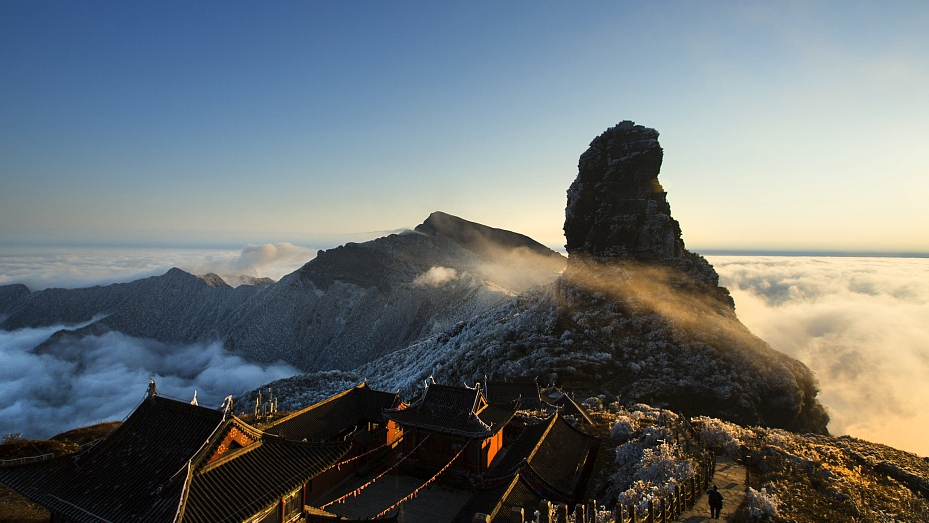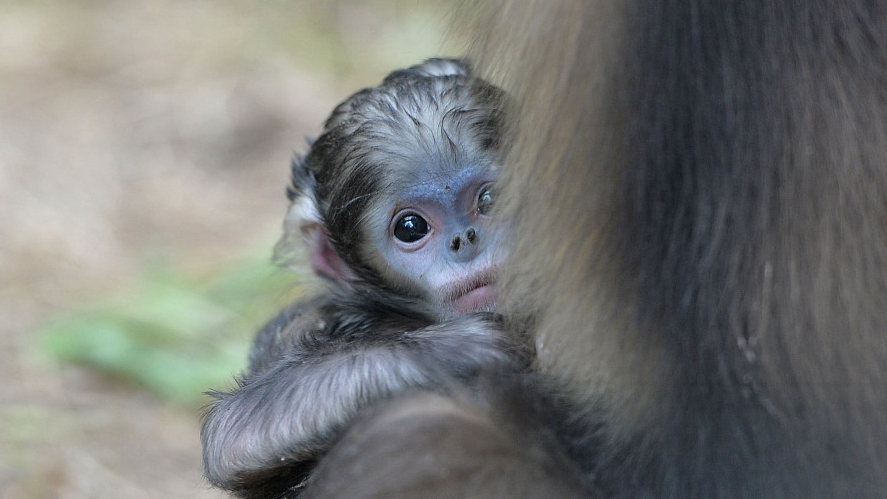
From the People's Daily app.
And this is Story in the Story.
Fanjing Mountain in Southwest China's Guizhou province has been included as one of the 28 destinations and experiences for 2019 by National Geographic Traveler magazine.
The only Chinese destination to be listed, together with Egypt's Cairo, Canada's Toronto and Vietnam's Hoang Lien Son, the mountain is described as "a sacred Buddhist site and a place rewarding hikers with bizarre rock formations and above-the-clouds views" by the magazine.
Home to 382 vertebrate species including wild panda and clouded leopard, the nature reserve is also the habitat of the largest number of gray snub-nosed monkeys in the world, around 700.
The rich biodiversity also earned it a place on the list of UNESCO world heritage sites last year.
Fanjing Mountain has become the 13th site in China included on UNESCO's natural heritage list.
Today’s Story in the Story looks at the rich diversity of animal and plant life that are sustained on this special mountain that is gaining international notoriety for China

UNESCO described the finger-like peak as an "island of metamorphic rock in a sea of karst." (Photo: VCG)
In tapping Fanjing Mountain for a listing, UNESCO officials note the mountain meets the criteria of a natural heritage site, namely a unique biodiversity and complete ecosystem.
UN officials also say the mountain maintains a subtropical mountain ecosystem and has distinct species diversity.
Fanjingshan, or Mount Fanjing, located in Tongren City in southwest China's Guizhou Province, is the highest peak in China's Wuling Mountain Range.
The altitude of Fanjingshan ranges from 480 to 2,570 meters above the sea level. The mountain is described as “an island of metamorphic rock in a sea of karst.”
The Fanjingshan National Nature Reserve was established in 1978. The relative isolation of the mountain creates an ideal home for many plants and animals. Endemic species such as Guizhou golden monkey and Fanjingshan fir have found their home here.
As the biodiversity hub of China, Fanjingshan contains over 2,000 different plants and 801 animals, and many of them originated in the Tertiary period (between 65 million and 2 million years ago). Endangered species such as the Chinese Giant Salamander, the Forest Musk Deer and the Reeve's Pheasant roam freely in the forests.
The name “Fanjing” means “Brahma's Pure Land.” But this mountain is considered a sacred mountain in Chinese Buddhism not just because of the long history of Buddhism here but because of the natural phenomenon caused by cloud, fog and light that adds mysterious elements to this place.
Ma Keping, a researcher with the Chinese Academy of Sciences' Institute of Botany, says it's the distinct geological and geographical conditions of Fanjing Mountain that has created its ecosystem.
"Featuring the karst landscape, Fanjing Mountain has formed its own shape. It stands out from its surroundings and developed into this unique biodiversity and ecosystem. Fanjing Mountain is distinctive, because it's the only habitat of the Guizhou golden monkey and Fanjing Mountain Firs. In other words, you can only find them here in Fanjing Mountain."
64 unique plants and flowers, as well as 38 animals species living on Fanjing Mountain, have been listed in the International Union for Conservation of Nature as vulnerable, endangered or critically endangered.

Guizhou Golden Monkey, also known as Gray Snub-nosed Monkey, is the most threatened out of the three snub-nosed monkey species in China. (Photo: VCG)
They include animals such as Giant salamanders, Forest Musk deer and Asian Black Bear.
Fanjing also includes one of the largest reserves of beech tree forests in Asia.
Now that Fanjing Mountain has UNESCO World Heritage status, it gives local conservation officials more access to international funds to help protect the site.
It also obliges officials to keep and maintain the site to the highest of standards.
As such, officials say they've already started to speed up local legislation to better protect the environment and ensure ecological preservation of the mountain.
Yang Tongguag, deputy mayor of Tongren, says they have to ensure that Fanjing doesn't become damaged by the likely increase in tourists to the site.
"In the early stages of applying for UNESCO world heritage, we had already drafted a protection and management plan. We will revise the plan now that the site has been included on the heritage list. In the future, any construction projects related to this area, being natural reserves or scenic spots, must be in line with the requirements in the plan."
Local officials say further conservation plans are now in the works as a result of the listing.
This year's World heritage committee meeting is discussing 28 nominations to the World heritage list, including five natural sites, 20 cultural sites and three mixed ones.
Currently China ranks just behind Italy as the country which boasts the most sites on UNESCO's World Heritage List.
(Produced by Nancy Yan Xu, Brian Lowe, Lance Crayon, Chelle Wenqian Zeng. Music by: bensound.com. Text from China Daily, CGTN, China Plus)


